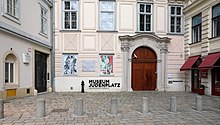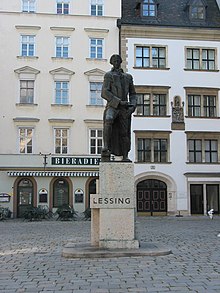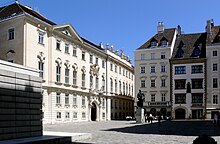Judenplatz
The Austrian Supreme Administrative Court has its seat on the square.
History

Jews began settling in Vienna and in the area that was to become Judenplatz around 1150, coinciding with the settlement of the House of Babenberg. The first written mention names named the area "Schulhof" in 1294, a name which lasted until the pogrom of 1421. By the year 1400, 800 inhabitants lived here including merchants, bankers, and scholars. The Jewish city extended north up to the church Maria am Gestade, the west side became Tiefer Graben street, the east side was bounded by Tuchlaubenstreet, and the south side formed the square "Am Hof". The Ghetto possessed 70 houses, which were arranged so that their back walls formed a closed delimitation wall. The Ghetto could be entered by four gates, the two main entrances lay on the Wipplingerstrasse.
At Judenplatz was the Jewish hospital, the Synagogue, the bath house, the house of the Rabbi and the Jewish school- all among the most important in German speaking countries. The synagogue lay between the later Jordangasse and Kurrentgasse streets. Because of the school the square bore the name "Schulhof" as it was a schoolyard at that time. Later this name was transferred to a smaller square situated in the immediate neighborhood, and the neighborhood is still called so today. The designation "Neuer Platz" was given to the original schoolyard in 1423, and since 1437 it has been called Judenplatz.
Vienna Gesera

In Vienna under Duke Albrecht V, the persecution of the Jews in the autumn of 1420 grew to a bloody climax in 1421. In the beginning were many imprisonments, with starvations and tortures leading to executions. Children were deprived and deceived into eating unclean foods, those that were defiant were "sold into slavery" or baptized against their will. The poor Jews were driven out, while the wealthy were imprisoned. The few Jews still living in freedom took refuge in the Or-Sarua Synagoge at Judenplatz, in what would become a three-day siege, through hunger and thirst, leading to a collective suicide, A contemporary chronicle exists, entitled the "Wiener Geserah", translated from German and Hebrew as the "Viennese Decree". It reported that the Rabbi Jonah set the Synagogue on fire for the Jews at Or-Sarua to die as martyrs. This was a form of Kiddush Hashem in order to escape religious persecution and compulsory baptism.
At the command of Duke Albrecht V, the approximately two hundred remaining survivors of the Jewish community were accused of crimes such as dealing arms to the Hussites and host desecration and on 12 March 1421 were led to the pyre at the so-called goose pasture (Gänseweide) in Erdberg and burned alive. The Duke decided at that time that no more Jews would be allowed in Austria henceforth. The properties that were left behind were confiscated, the houses were sold or given away, and the stones of the synagogue were taken for the building of the old Viennese university. However, Jewish settlement in Vienna would not cease as the Duke intended, and a second major ghetto would emerge in Vienna's Leopoldstadt district in the seventeenth century.
Holocaust Memorial


In the middle of the northern end of the square, the Judenplatz Holocaust Memorial stands for the Austrian Jewish victims of the Shoah, made by the English artist Rachel Whiteread. It consists of a 10 by 7 metre block that is 3.8 metres tall. It is located in the northwestern end of the square before the Misrachi-Haus and faces the Lessing Monument in the southeast, with its walls parallel to the length of the square. The memorial is site-specific in many ways and is therefore dependent on the setting of Judenplatz. One facet of this site-specificity is that it was designed at a domestic scale. It was imagined as if one of the surrounding buildings had a room cast inside out and placed in public in the middle of the square. The walls of the memorial resemble library walls of petrified books. However, the spines of the books on the walls are not legible; they all are turned inwards. On a concrete plinth, the names of the 41 places at which Austrian Jews went to their death during Nazi rule are written. Although this "nameless" library has a symbolic entrance, it is not accessible. The memorial stands in close relation with the exhibition of the Holocaust that is installed in the neighboring Misrachi-Haus, where the names and data of 65,000 murdered Austrian Jews are documented and accessible through computer terminals.
Excavations were undertaken to establish the Memorial from July 1995 to November 1998; these are considered the most important urban archaeological investigations in Vienna. Uncovered on the eastern half of the square were quarrystone walls, a well and cellars of a whole block from the time of a medieval synagogue. Controversy arose over the placing of the memorial over the archaeological excavations, which resulted in moving the memorial one meter from its original position on the site. The complete reorganization of the square and its transformation to a pedestrian plaza were completed in the autumn of 2000 with the inauguration of the Holocaust memorial.

Misrachi-Haus

At Judenplatz 8 is the Misrachi-Haus. It was built in 1694 and is today a branch of the Jewish Museum Vienna. Under the square archaeologists found, in 1995, the foundation walls of one of Europe's biggest medieval synagogues and exposed them. With the archaeological findings came the idea to unite the memorial and excavations into a commemorative museum complex.
The erection of a museum sector in the Misrachi-Haus was conceived in 1997 to supplement the show area at Judenplatz 8. In addition to the archaeological findings, exhibitions by a branch of the Jewish Museum Vienna would document Jewish life in the Middle Ages as well as the data base produced by the Documentation Archive of the Austrian Resistance with the names and fates of Austrian Holocaust victims.
In the exhibition, importance is particularly attached to the circumstances of the Jews in "Wiener Geserah", the pogrom in the year 1421. Remains of the synagogue from before the pogrom are to be seen in three areas; these consist of the men's teaching and praying area called the "men's shul", a cultivated smaller area that was used by the women, and the foundation of the hexagonal bimah, the elevated platform for Torah reading.
Lessing monument

In the center of the southern end of the square is the monument to the German poet Gotthold Ephraim Lessing created by Siegfried Charoux (1896-1967). Charoux won the commission in 1930 in a competition with eighty two other sculptors. The monument was completed in 1931/32, unveiled in 1935, and soon removed in 1939 by the National Socialists to be melted down for the purpose of making weaponry. Lessing was in Vienna in 1775/76, had an audience with Joseph II., and was therefore in a position to influence and shape the Viennese cultural climate. Lessing's "Ringparabel" in the drama "Nathan der Weise" is considered a key text of the Enlightenment and helped in the formulation of the idea of tolerance. From 1962 to 65, Charoux created a second Lessing monument out of bronze, that was unveiled at Ruprechtskirche in 1968 and moved to Judenplatz in 1981. This is the monument that stands on the square today.
Bohemian Court Chancellery

The former Bohemian Court Chancellery (Böhmische Hofkanzlei), Judenplatz 11, is the seat of the Austrian Supreme Administrative Court (Verwaltungsgerichtshof). The building was erected from 1709 to 1714 to the designs of Johann Bernhard Fischer von Erlach. After 1749, the remaining lots of the block were bought up and Matthias Gerl was put in charge of the expansion of the palace from 1751 to 1754, symmetrically doubling the construction westward. Further rebuilding took place in the 19th century, the palace essentially received its present-day look at that time. The façade on Judenplatz was originally the back of the building, only since changes in the 20th century has the main entrance gate been found there. The female figures over the gates of this building represent the Cardinal virtues (moderation, wisdom, justice and bravery), and above are the coats of arms of Bohemia and Austria. In the middle of the attic line, an angel stands with trombone, at whose feet a Putto crouches. Four vases and two male figures who are presumably Bohemian Kings Wenceslaus I and Wenceslaus II are at the angel's sides.
The building was originally the official seat of the Bohemian Court Chancellery, which was united organizationally with the Austrian Court Chancellery in 1749. In 1848, occupancy changed to the Ministry of the Interior which remained in the palace until 1923. From 1761 to 82 and 1797 to 1840 resided also the Oberste Justizstelle, the forerunner of the Austrian Supreme Court (Oberster Gerichtshof). In 1936, the Bundesgerichtshof moved into the palace, and on 12 March 1945 a part of the building was destroyed by a bomb strike. The rebuilding was under the management of the architect Erich Boltenstern and was completed in 1951. From 1946 to 2014, the palace was the seat of both the Supreme Administrative Court and the Constitutional Court; in 2014, the Constitutional Court moved to the Freyung.
References
- ^ Brigitte Hamann, translated by Thomas Thornton, Hitler's Vienna: A Dictator's Apprenticeship, Oxford University Press, 1999, page 325, ISBN 0-19-514053-2
- ^ Heidrun Helgert, Die spätmittelalterliche Synagoge auf dem Judenplatz in Wien Die Deutsche Gesellschaft für Archäologie des Mittelalters und der Neuzeit e.V, accessed 20 May 2007.
- ^ wissen.de Judenplatz Archived 2007-09-27 at the Wayback Machine, Munich, accessed 20 May 2007.
- ^ Museum Online, Das erste Wiener Ghetto Archived 2005-10-30 at the Wayback Machine accessed 23 May 2007.
- ^ Jewish Museum Vienna, Wiener Einstellungen Archived 2007-09-27 at the Wayback Machine accessed 23 May 2007.
- ^ Salo W. Baron, Social and Religious History of the Jews, Volume 10: On the Empire's Periphery, Columbia University Press, 1965, page 420, ISBN 0-231-08847-7
- ^ Viktor Böhm, Jordanhaus - Judenplatz 2 - 1010 Wien Verein für Geschichte und Sozialkunde, accessed 22 May 2007.
- ^ Camillo Schaefer, Kammerknechte des Herzogs: Die Judengemeinde im mittelalterlichen Wien - Ein historischer Streifzug Archived 2007-09-30 at the Wayback Machine Wiener Zeitung, 1 May 1998.
- ^ Gerhard Langer, Der Wiener Judenplatz Archived 2007-03-13 at the Wayback Machine, University of Salzburg: Center for Jewish Culture and History, transcription of a lecture given in 1998 in Vienna.
- ^ Dagmar C. G. Lorenz, Gabriele Weinberger, Insiders and Outsiders: Jewish and Gentile Culture in Germany and Austria, Wayne State University Press, 1994, ISBN 0-8143-2497-5
- ^ Jewish Museum Vienna, JUDENPLATZ - Place of Remembrance Archived 2003-04-01 at the Wayback Machine Press release, Winter 2000/2001, accessed 23 May 2007.
- ^ John Tusa, and Rachel Whiteread, Transcript of the John Tusa Interview with Rachel Whiteread, BBC Radio, accessed 4 June 2007.
- ^ Jewish Museum Vienna, flyer accessed 23 May 2007
- ^ City of Vienna, Abgeschlossene Grabung 1., Judenplatz - Stadtarchäologie Wien accessed 23 May 2007.
- ^ James Edward Young, At Memory's Edge: After-Images of the Holocaust in Contemporary Art and Architecture, Yale University Press, 2000 ISBN 0-300-09413-2
- ^ Documentation Archive of the Austrian Resistance, Gedenkkomplex Judenplatz: Ort des Lernens, Ort der Erinnerung Archived 2007-09-28 at the Wayback Machine accessed 21 May 2007.
- ^ Gotthold Ephraim Lessing, Translated by H. B. Nisbet, Philosophical and Theological Writings Cambridge University Press, 2005, ISBN 0-521-83120-2.
- ^ Hedwig Abraham, Siegfried Charoux: Bildhauer, 1896 - 1967 accessed 18 May 2007.
- ^ Austrian Administrative Court of Justice, Baugeschichte Archived 2007-07-02 at the Wayback Machine accessed 19 May 2007.
- ^ Austrian Constitutional Court of Justice Gebäude Archived 2007-07-04 at the Wayback Machine accessed 19 May 2007.
- ^ Austrian Administrative Court of Justice, Judenplatz Archived 2007-07-02 at the Wayback Machine accessed 19 May 2007.
- ^ Austrian Administrative Court of Justice, Behördengeschichte Archived 2007-07-02 at the Wayback Machine accessed 19 May 2007.
Further reading
- Judenplatz Wien 1996. Wettbewerb Mahnmal und Gedenkstätte für die jüdischen Opfer des Naziregimes in Österreich 1938–1945. Mit Beiträgen von Simon Wiesenthal, Ortolf Harl, Wolfgang Fetz u. a., Wien 1996
- Simon Wiesenthal (Hg.) Projekt: Judenplatz Wien. Zur Rekonstruktion von Erinnerung, Zsolnay, Wien 2000
- Gerhard Milchram [Hrsg.] Judenplatz: Ort der Erinnerung, Pichler, Wien 2000 ISBN 3-85431-217-2
- Adalbert Kallinger: Revitalisierung des Judenplatzes. Wien, Selbstverlag, 1974
- Ignaz Schwarz: Das Wiener Ghetto, seine Häuser und seine Bewohner, Wien 1909
- Samuel Krauss: Die Wiener Geserah vom Jahre 1421. Braumüller, Wien und Leipzig 1920
External links
![]() Media related to Judenplatz, Vienna at Wikimedia Commons
Media related to Judenplatz, Vienna at Wikimedia Commons